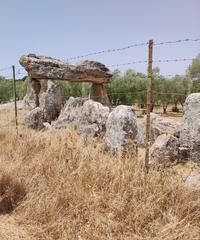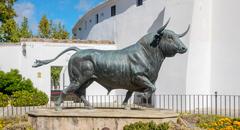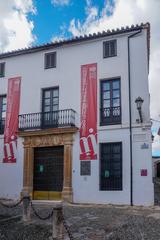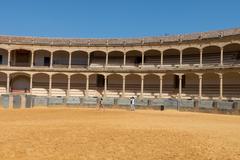Dolmen Del Gigante: Visiting Hours, Tickets, and Comprehensive Guide to Ronda Historical Sites
Date: 14/06/2025
Introduction
Nestled in the heart of Andalusia’s striking landscapes, the Dolmen Del Gigante stands as a remarkable testament to prehistoric ingenuity and ritual. Located near El Gastor, close to Ronda in southern Spain, this megalithic corridor tomb offers visitors a unique opportunity to step back in time and explore the beliefs, burial customs, and community life of Neolithic and early Bronze Age societies. With its awe-inspiring stone architecture and scenic setting within the Sierra de Grazalema Natural Park, the Dolmen Del Gigante is both an archaeological marvel and a cultural icon linked to local legends of giants.
This guide provides up-to-date, detailed information for travelers—including visiting hours, ticketing, how to access the site, available tours, nearby attractions, travel tips, and advice on integrating your visit with Ronda’s rich historical offerings. For the most current resources, consult official tourism platforms such as Official Andalusia Tourism and local guides. This article synthesizes visitor information and archaeological research to help you plan an unforgettable journey to one of Spain’s most captivating prehistoric sites (Cadiznet, Wikipedia, Visiting Cádiz).
Contents
- What is the Dolmen Del Gigante?
- Historical and Archaeological Significance
- Context & Chronology
- Construction Features
- Funerary Practices
- Regional Importance
- Visitor Information: Hours, Tickets, and Accessibility
- Getting There: Transport and Hiking
- On-site Experience and Features
- Nearby Attractions and Suggested Itineraries
- Travel Tips and Accessibility
- Conservation and Responsible Tourism
- Frequently Asked Questions (FAQ)
- Visual Highlights and Further Resources
- References
What is the Dolmen Del Gigante?
The Dolmen Del Gigante is a corridor-type megalithic tomb, constructed between 4000 and 2000 BCE. Its massive upright stones (orthostats) and enormous capstones reflect the advanced engineering and communal effort of early agrarian societies in Andalusia. Serving both as a burial chamber and a ritual space, the dolmen has inspired local myths about giants as its builders, further enhancing its cultural mystique.
Historical and Archaeological Significance
Context & Chronology
Dating back over 4,000 years to the late Neolithic and early Bronze Age, the Dolmen Del Gigante (also known as Dolmen de El Charcón or Tumba del Gigante) marks a period of significant social and technological transition. This era saw the rise of settled farming communities, communal burial traditions, and monumental stone architecture (Cadiznet; Visiting Cádiz).
Construction Features
The dolmen is classified as a corridor or gallery tomb. Its main passage is approximately 9–12 meters long and nearly 2 meters high, comprised of large upright stones topped by horizontal capstones. Originally, the structure was buried beneath a tumulus of earth and smaller stones (Grazalema Guide). The site’s elevated position provides panoramic views and likely held symbolic meaning for its builders.
Funerary Practices
Excavations have yielded grave goods such as polished axes, flint arrowheads, and pottery fragments, indicating the dolmen’s use as a communal burial site and its significance in ancestor veneration (Cadiznet). These traditions link the monument to a broader network of megalithic sites across Andalusia, such as the Antequera dolmens (Ronda Today).
Regional Importance
Dolmen Del Gigante is one of several prehistoric sites in the Sierra de Cádiz and Serranía de Ronda, and its construction aligns with a longstanding tradition of megalithic monuments in Iberia. The dolmen’s prominence and enduring preservation make it a key site for understanding southern Spain’s ancient heritage.
Visitor Information: Hours, Tickets, and Accessibility
- Visiting Hours: The Dolmen Del Gigante is accessible year-round during daylight hours (typically 8:00 AM to sunset).
- Tickets: Admission is free. There are no formal ticketing facilities or entrance booths.
- Guided Tours: Local tour operators in El Gastor and Ronda offer guided hikes and interpretive visits; these may require advance booking and a fee.
- Accessibility: The site is reached via a moderate hiking trail and is not wheelchair accessible. The terrain is uneven and may be challenging for visitors with limited mobility.
Getting There: Transport and Hiking
By Car
- From Ronda: Take the A-374 towards Algodonales, then CA-4401 to El Gastor (approx. 40 minutes by car).
- Parking: Available in El Gastor, particularly near the Área Recreativa La Ladera, which serves as the main trailhead.
By Public Transport
- Buses: Limited service connects Ronda and El Gastor. Check current timetables, as schedules are infrequent (Rome2Rio: Ronda to El Gastor).
- From El Gastor: The dolmen is best reached on foot via a marked trail.
Hiking Trail
- Trailhead: Área Recreativa La Ladera, El Gastor.
- Distance: Approximately 2 km (1.2 miles) each way, moderate incline.
- Estimated Time: 30–40 minutes each way.
- Trail Features: Mediterranean woodland, open countryside, and scenic overlooks.
Wear sturdy footwear, bring sufficient water, and use sun protection, especially in warmer months.
On-site Experience and Features
- Dolmen Structure: The tomb’s upright orthostats and massive capstones are well preserved and accessible for close viewing.
- Interpretive Signage: Basic informational panels (in Spanish) are provided at the site.
- Scenic Surroundings: Panoramic views of Sierra de Grazalema, Zahara-El Gastor reservoir, and El Gastor village.
- Photography: The site and its surroundings offer excellent photographic opportunities.
There are no toilets or shops at the site; amenities are available in nearby El Gastor.
Nearby Attractions and Suggested Itineraries
El Gastor
Known as the “Balcony of the White Villages,” El Gastor offers a traditional Andalusian experience with local museums, restaurants, and seasonal festivals.
Ronda Historical Sites
Combine your dolmen visit with Ronda’s attractions:
- Puente Nuevo: Iconic bridge over El Tajo gorge.
- Arab Baths and Old Town: Explore Moorish and medieval heritage.
- Museums: The Municipal Museum (Mondragón Palace) houses relevant archaeological collections.
Other Megalithic Sites
Extend your itinerary to include nearby dolmens, such as Dolmen de la Giganta and Dolmen de Alberite (Andalucía Información: Dolmen de Alberite).
Natural Parks and White Villages
Hike in Sierra de Grazalema or explore the Pueblos Blancos, including Zahara de la Sierra and Grazalema.
Travel Tips and Accessibility
- Best Time to Visit: Spring (March–May) and autumn (September–November) offer mild weather and lush landscapes.
- What to Bring: Sturdy walking shoes, water, sun protection, snacks, and a camera.
- Facilities: No on-site services; prepare accordingly.
- Accessibility: The hike is not suitable for wheelchairs or those with limited mobility.
Conservation and Responsible Tourism
- Respect the Site: Do not climb on stones or remove artifacts.
- Stay on Trails: Protect the fragile landscape and archaeological features.
- Leave No Trace: Carry out all litter and respect wildlife.
Frequently Asked Questions (FAQ)
Is there an entrance fee?
No, the site is free to visit.
What are the visiting hours?
The dolmen is accessible during daylight hours year-round.
Is the site wheelchair accessible?
No; the trail has uneven terrain and moderate inclines.
Are guided tours available?
Yes, local guides offer tours from El Gastor and Ronda.
What is the best time to visit?
Spring and autumn provide the most comfortable conditions.
Are there facilities at the site?
No; facilities are available in El Gastor.
Visual Highlights and Further Resources
Enjoy panoramic views and exceptional photography opportunities at the dolmen and surrounding countryside. For virtual tours and additional images, visit Official Andalusia Tourism and regional heritage sites.
References
- Official Andalusia Tourism
- Dolmen Del Gigante in Ronda, Spain: Visiting Hours, Tickets, and Historical Significance - Cadiznet & Grazalema Guide
- Visiting Cádiz: El Gastor - Exploring the Balcony of Cádiz’s White Villages
- Wikipedia: Dolmen del Gigante
- Ronda Today: Antequera’s Dolmen Structures
- Grazalema Guide
- Dolmen Del Gigante Hiking Route - Wikiloc
- Andalucía Información: Dolmen de Alberite



